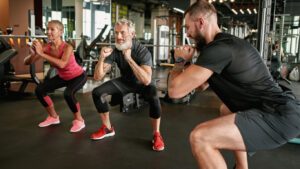
The world after military service can be tough, especially for veterans dealing with Post-Traumatic Stress Disorder (PTSD). The symptoms of PTSD can be overwhelming, but there’s a powerful, natural tool that can help: regular exercise. Not only can exercise improve your mental and physical health, but it can also play a crucial role in supporting your disability claims. Let’s dive deeper into how regular exercise can help veterans with PTSD and their disability claims.
Call or text (800) 562-9830 or complete a Free Case Evaluation form
Understanding PTSD in Veterans
PTSD is a mental health condition triggered by experiencing or witnessing traumatic events. For many veterans, the stress and trauma of military service can lead to the development of PTSD. Symptoms might include flashbacks, nightmares, severe anxiety, and uncontrollable thoughts about the traumatic event. These symptoms can disrupt everyday life and make it challenging to transition back to civilian life.
For a free legal consultation, call (800) 562-9830
The Benefits of Regular Exercise for PTSD
Exercise is not just about physical health—it’s a powerful tool for mental well-being too. Here’s a detailed look at how it can help veterans with PTSD:
- Reducing Anxiety and Depression
Regular physical activity has been shown to reduce symptoms of anxiety and depression. When you exercise, your brain releases endorphins, which are natural mood lifters. For veterans with PTSD, this can mean less severe symptoms and an overall improvement in mood. Think of it as a natural antidepressant that you can access any time.
- Improving Sleep Patterns
Many veterans with PTSD struggle with sleep issues, like insomnia and nightmares. Regular exercise can help you sleep better by reducing anxiety and promoting relaxation. Establishing a consistent exercise routine can help regulate your body’s internal clock, making it easier to fall asleep and stay asleep. Imagine finally getting a good night’s sleep without the constant interruptions.
- Enhancing Cognitive Function
Exercise increases blood flow to the brain, which helps improve cognitive function. This can be particularly beneficial for veterans with PTSD, who often experience difficulties with memory and concentration. Better cognitive function means you’ll find it easier to manage daily tasks and feel less frustrated by cognitive challenges.
- Providing a Sense of Routine and Purpose
Engaging in regular exercise can give your day structure and a sense of routine, which is incredibly helpful for those coping with PTSD. The discipline and commitment required for regular workouts can also give you a sense of purpose and accomplishment. It’s about more than just staying fit—it’s about reclaiming control over your life.
- Offering a Healthy Outlet for Stress
Exercise provides a healthy way to channel stress and frustration. Activities like running, swimming, or even yoga can help release built-up tension and provide a constructive way to cope with stress. Instead of bottling up your stress, you can let it out in a way that benefits your body and mind.
Exercise and Disability Claims: Making the Connection
Regular exercise can also support your disability claims. Here’s how:
- Documenting Efforts to Manage PTSD
Engaging in regular exercise can be part of your documented effort to manage PTSD symptoms. Medical professionals and legal representatives can include your exercise routines as evidence that you’re taking proactive steps to cope with your condition. This shows that you’re actively working to improve your health, which can strengthen your claim.
- Providing Tangible Improvement Data
Improvement in symptoms through exercise can be tracked and recorded, providing tangible data to support your disability claims. This data can include reduced anxiety levels, better sleep patterns, and improved cognitive function. All these improvements are relevant to the severity of your PTSD and can support your case.
- Strengthening the Overall Health Argument
Regular exercise contributes to overall physical health, which can help demonstrate that your PTSD is a distinct condition, not a result of other health issues. Showing that you’re otherwise healthy can reinforce the validity of your PTSD claim, making it clear that your symptoms are directly related to your service.
- Enhancing Credibility
A commitment to managing your condition through regular exercise can enhance your credibility in the eyes of evaluators. It shows that you’re proactive about your health and willing to engage in beneficial activities, which can positively influence the outcome of your disability claim.
Types of Exercise Suitable for Veterans with PTSD
Finding the right type of exercise can make all the difference. Here are some types of exercise that can be particularly helpful:
- Aerobic Exercise
Activities like running, cycling, and swimming can boost your cardiovascular health and release endorphins, helping to reduce anxiety and depression. Start with short, manageable sessions and gradually increase the duration and intensity as you feel more comfortable.
- Strength Training
Lifting weights or engaging in resistance training can improve your physical strength and provide a sense of empowerment and control. Even simple bodyweight exercises like push-ups, squats, and planks can be highly effective.
- Yoga and Mindfulness-Based Exercise
Yoga and tai chi combine physical activity with mindfulness and deep breathing, which can help reduce stress and promote relaxation. These activities are gentle on the body and can be adapted to your fitness level.
- Group Sports and Activities
Participating in group sports or exercise classes can provide social interaction and support, which is beneficial if you’re feeling isolated due to PTSD. Consider joining a local sports league, a hiking group, or an exercise class at a community center.
Starting and Maintaining an Exercise Routine
Starting an exercise routine can be daunting, especially if you’re struggling with PTSD. Here are some tips to help you get started:
- Consult a Healthcare Provider: Before starting any exercise program, consult your healthcare provider to ensure the activities are safe and appropriate for you.
- Start Slow: Begin with low-intensity activities and gradually increase the intensity and duration as your fitness improves. The goal is to make exercise a regular part of your life without overwhelming yourself.
- Set Realistic Goals: Set achievable goals and celebrate your progress to stay motivated. Whether it’s walking for 20 minutes a day or doing a short yoga session, every bit counts.
- Find Enjoyable Activities: Choose activities that you enjoy to ensure consistency and long-term commitment. If you love the outdoors, try hiking or cycling. If you prefer indoor activities, consider yoga or strength training.
- Seek Support: Join exercise groups or find a workout buddy for mutual support and accountability. Having someone to share your journey with can make it more enjoyable and help you stay committed.
Regular exercise offers numerous benefits for veterans with PTSD, from reducing anxiety and improving sleep to providing a sense of purpose and routine. Additionally, a consistent exercise regimen can support disability claims by documenting efforts to manage PTSD and providing tangible data on symptom improvement. By incorporating regular exercise into your routine, you can enhance your mental health and strengthen your disability claims, paving the way for a healthier and more empowered future.
Remember, you’re not alone—there are resources and professionals ready to assist you every step of the way.





